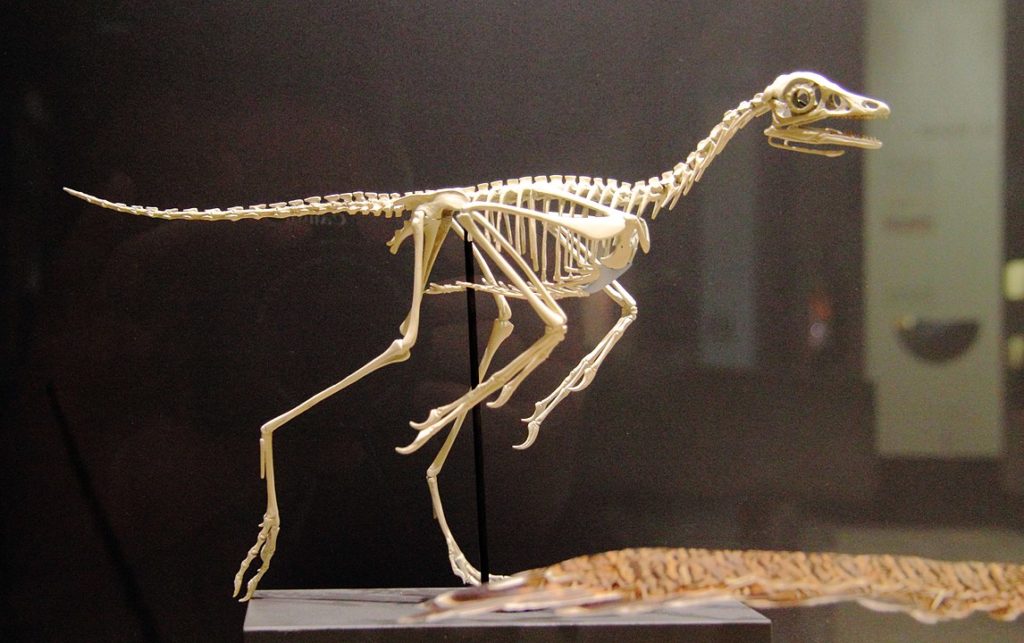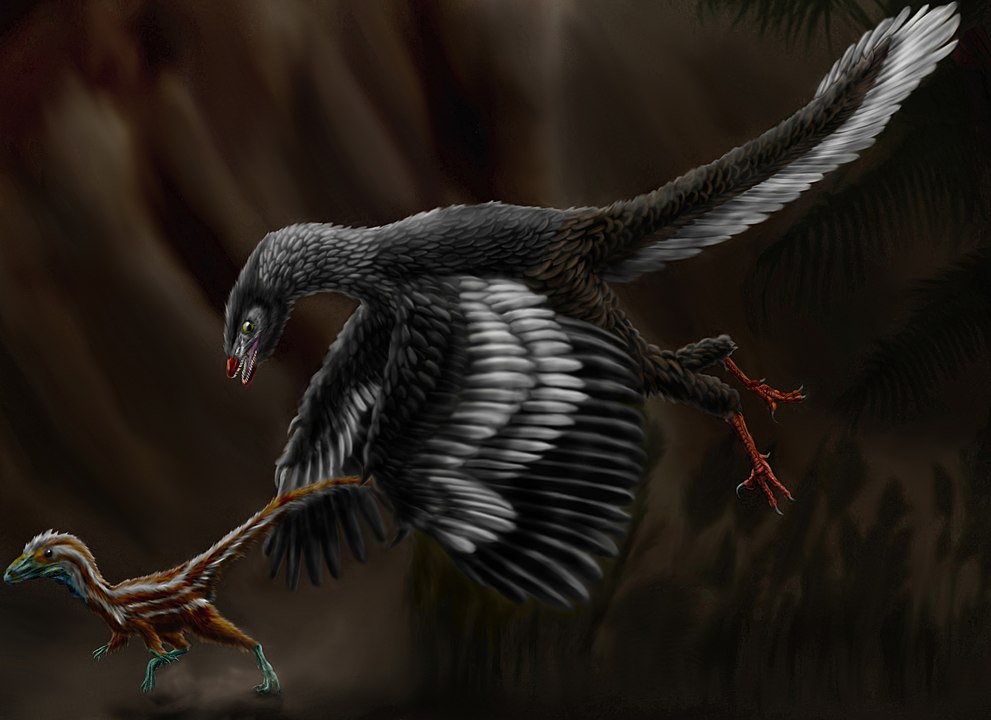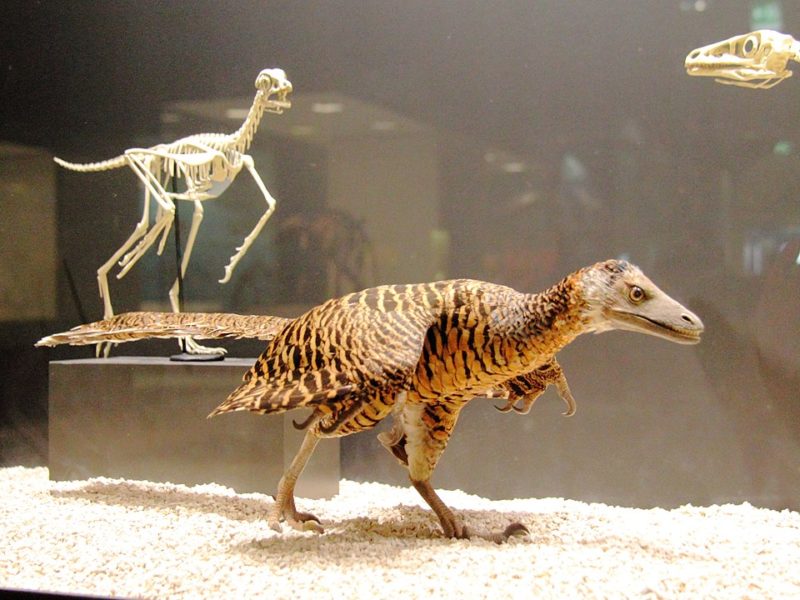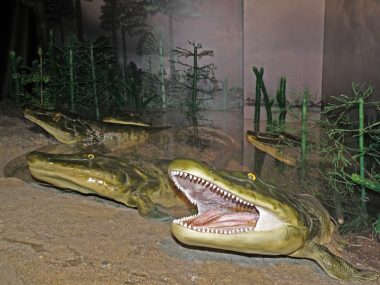Scientists were in for a surprise when the fossilized skeleton of an unusual creature was discovered in 1861 at Bavarian, Germany’s Solnhofen Limestone. This site is famous for its exquisitely-preserved fossils. This creature had the feathers of a bird, but it also had the clawed forelimbs, toothed jawed, and long, bony tail of a theropod (meat-eating) dinosaur. In 1863 Sir Richard Owen described it under the name Archaeopteryx, meaning “ancient wing.”
The views expressed in this article reflect those of the author mentioned, and not necessarily of New Creation.
But to what group of animals did Archaeopteryx belong? Since birds are the only animals that have feathers today, Owen considered this creature to be an unusual type of bird.1 Most creationists have followed suit, arguing that Archaeopteryx is nothing more than an odd perching bird.2 But what kind of bird has a long, bony tail?
Let’s Get to Know the Ancient Wing

Archaeopteryx is unique in that its perfectly preserved remains allow us to know a lot more about it than most extinct animals. It was about the size of an American crow and was a carnivore, hunting for animals smaller than itself. Archaeopteryx also had an enlarged, retractable claw on its second toe, similar to that seen in Velociraptor. Comparisons of its sclerotic (eye) bones to those of other birds and reptiles indicate that Archaeopteryx would have been active primarily during the day.3 Its feathers are so well-preserved that scientists can study the pigment-producing cells. These studies suggest that Archaeopteryx was at least partially black in color.4
As mentioned above, Archaeopteryx had a blend of reptilian and bird features. Its more “bird-like” characteristics include:
- Feathers
- Brain structure
- Inner ear
- Air sacs
Whereas its decidedly more “reptilian-like” characteristics include:
- Toothed jaw
- Long, bony tail
- Gastralia (“belly ribs”)
- Clawed forelimbs
It was once thought that Archaeopteryx had a reversed toe that would have allowed it to perch on branches like many birds today. Better preserved specimens revealed this not to be the case.5
Is Archaeopteryx Just a Bird?
The problem that comes from Archaeopteryx being “just an unusual bird” is that it shares many features with animals that most would regard as not being birds. Majungasaurus, for example, was a mid-sized, featherless theropod. Yet, it had air sacs, much like modern birds do.6 Instead of trying to classify every animal with feathers as a bird, we ought to reconsider how we define the word “bird.”
What Exactly is a Bird Anyway?

Zoologist Dr. Marc Surtees has recently developed a set of new criteria to distinguish birds from non-birds:7
- A sophisticated flow-through lung connected to air sacs
- Lightweight, air-filled bones
- A robust wing attachment site consisting of the wishbone, shoulder blade, and coracoid (a type of shoulder bone)
- A hook-like extension of the coracoid called the acrocoracoid
- Pygostyle (rod-like or blade-like bone at the end of the tail)
- Brain with enlarged cerebellum and visual cortex
Dr. Surtees states that while some animals may have some of the features listed above, true birds should possess all of them. For example, despite having a sophisticated flow-through lung connected to air sacs, Majungasaurus was not a bird because it lacked many of the traits listed above. Based on these criteria, now-extinct toothed birds like Hesperornis and Ichthyornis, and of course, modern birds, can be officially classified as “true birds.”
Interestingly, Archaeopteryx is missing many of these criteria, including a pygostyle. This means that, based on these criteria, it is actually not a bird at all. This makes sense in light of recent research by creation paleontologists. While Archaeopteryx has proven difficult to classify, several analyses have placed it as a close relative of small, feathered dinosaurs like Velociraptor and the troodontids.8,9 This suggests that Archaeopteryx was, in fact, not a true bird at all.
Conclusion

We often charge our old-earth colleagues with allowing their biases to cloud their interpretation of the data. But the reality is that all of us have biases that may cloud the proper interpretation of scientific data. As far as Archaeopteryx is concerned, we have often been guided by the extra-biblical assumption that birds can be the only thing with feathers. This has made a mess of bird/dinosaur classification schemes. There is no way to completely remove the existence of our biases. But we must always be willing to change our minds on a certain issue when either biblical or scientific data does not fit our initial perception. Archaeopteryx has taught us that God’s creation is still full of many wonderful (and feathered) mysteries left to solve.
Footnotes
- Owen, R. 1863. “On the Archaeopteryx of von Meyer, with a description of the fossil remains of a long-tailed species, from the lithographic stone of Solenhofen.” Philosophical Transactions of the Royal Society of London 153:33-47. ↩︎
- Gish, D. 1989. “As a Transitional Form Archaeopteryx Won’t Fly.” Acts & Facts. 18 (9). ↩︎
- Schmitz, L.; Motani, R. 2011. “Nocturnality in Dinosaurs Inferred from Scleral Ring and Orbit Morphology.” Science. 332 (6030): 705–8. ↩︎
- Carney, R.M. Tischlinger, H. Shawkey, M.D. 2020. “Evidence corroborates identity of isolated fossil feather as a wing covert of Archaeopteryx“. Scientific Reports. 10 (1): 15593. ↩︎
- Mayr, G., Pohl, B., Peters, D. 2005. “A Well-Preserved Archaeopteryx Specimen with Theropod Features.” Science. 310 (5753): 1483–1486. ↩︎
- O’Connor, Patrick M., Claessens, Leon, P.A.M. 2006. “Basic avian pulmonary design and flow-through ventilation in non-avian theropod dinosaurs.” Nature. 436 (7048): 253–256. ↩︎
- Surtees, M. 2021. “Is it a bird? A critical analysis of feathered fossils.” Journal of the Biblical Creation Trust. Volume 3, pages 12–19. ↩︎
- McLain, M.A., M. Petrone, and M. Speights. 2018. “Feathered dinosaurs reconsidered: New insights from baraminology and ethnotaxonomy.” In Proceedings of the Eighth International Conference on Creationism, ed. J.H. Whitmore, pp. 472–515. Pittsburgh, Pennsylvania: Creation Science Fellowship. ↩︎
- McLain, M.A. 2020. “Feathered dinosaurs and the creation model.” Journal of the Biblical Creation Trust. Volume 2, pages 2–8. ↩︎












Is it a bird , a plane , or a reptile? No, it’s Super-bird!
Over 20 yrs ago, some dinosaurs were discovered that had feathers. We know this because of fossil imprints on rocks in China, maybe other places but China is the place I remember them being discovered. It was concluded that some dinosaur species had feathers.
Yes, most of these excellently-preserved feathered dinosaurs we have discovered so far have come out of China. But they are being found in other places too. Shuvuuia was found in Mongolia, Sciurumimus was found in Germany, and Ornithomimus is known from right here in America.
This reminds me of the duck-billed platypus, with characteristics that seem to contradict…but there it is.
Excellent article. It helps move creationists toward the conclusion, that I insist they must move to, that there were no dinosaurs. these creatures were misidentified in the 1800’s by the few who found them. So yes these are birds. All theropod dinos are flightless ground birds. they don’t have reptile traits. They simply are birds with teeth. Even evolutionists admit flying birds have been found in fossils with teeth. likewise a tal is no big deal in nature if you need it.The bone left out here is the WISHBONE. Wiki wishbone and one notes that only birds and thertopods had it. I say only birds had it.Etc etc etc.
T rex was just a giant tough turkey etc.
We just must allow imagination to allow options on how diverse birds could become in the old days. Insisting theropods are lizards will retard creationists on dinosaur investigation.
thanks for this. a new conclusion i had not heard before
Solnhofen is in Bavaria not Berlin
Thank you for catching that! We’ll update the article.
Interesting article, Christian, but it is far from a proven fact that velociraptors and troodontids are feathered dinosaurs–or that much of the evidence for so-called “feathered dinosaurs” coming out of China are actually feathers. On the contrary, credible scientists, both secular and creationist, have shown most claims of feathers on Cretaceous dinosaur fossils are actually cartilaginous tissue, as found in the spines of iguanas.
You would do well to join (if you haven’t already) the Creation Research Society, which maintains a data base of thousands of creation science articles for its members. You and also access similar data bases through the Alpha-Omega Inst. and Creation Ministries Int. I believe that AiG and ICR have in-house access to virtually all of their articles, as well.
Greetings, Terry,
While I agree that the classification of dromaeosaurs (e.g. Velociraptor) and troodontids does need to be cleaned up, I think there is good reason to consider them true feathered dinosaurs. Various species of dromaeosaurs (like Zhenyuanlong) and troodontids (like Jianianhualong) have been discovered with body, wing, and tail feathers, similar to those of modern birds. Even other major young-earth organizations, like our friends over at Answers in Genesis, acknowledge that these really are feathers (though I believe they would classify them as non-dinosaurian birds). Additionally, there are a number of key defining features used to delineate certain animals as dinosaurs. One of them is a hole in the hip socket called the perforated acetabulum. Both dromaeosaurs and troodontids possess this trait, meaning, by definition, they are feathered dinosaurs.
Also, thank you for your suggestion that I join the Creation Research Society. I have had a couple other individuals urge me to do that as well, so now I will be sure to do that!
Thank you, Ryan, for this article.
I’m wondering whether we could use the criteria to distinguish birds from non-birds by Dr. Marc Surtees for the flying creatures that had been created after their kinds during the Creation Week.
Hope I could learn more about the baraminology about the flying creatures including birds -:)
Hello Mary!
I’m glad you enjoyed the article. Dr. Surtees’ criteria for distinguishing birds can definitely be applied to other creatures aside from Archaeopteryx. So far this has not been done, but it might make for an interesting research project should someone want to partake in it!